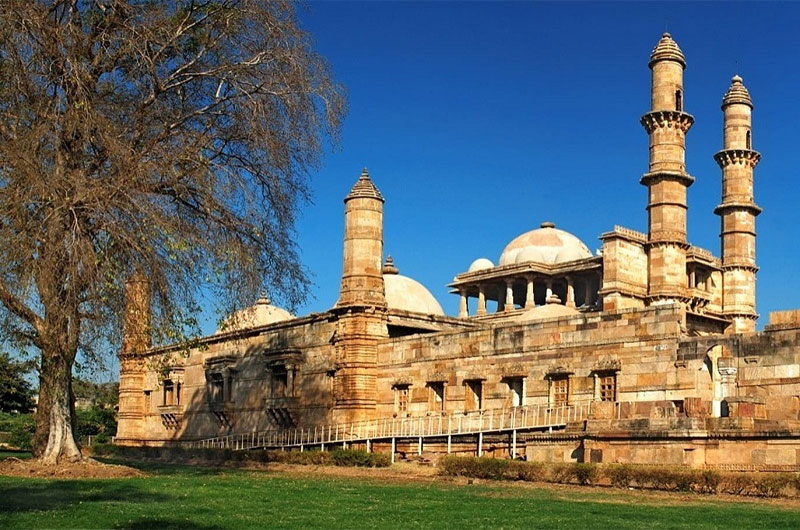
Champaner-Pavagadh Archaeological Park: Timeless Treasures of Gujarat – A World Heritage Site
18/06/2024
Champaner-Pavagadh Archaeological Park, situated in Gujarat, India, is a UNESCO World Heritage Site celebrated for its historical and architectural significance. This park encompasses the remains of a fortified city, religious buildings, water installations, and other structures dating from the 8th to the 14th centuries. It represents a blend of Hindu-Muslim architecture and showcases the cultural exchange and architectural achievements of the region during that period.
Historical Background
- Foundation and Development
- Founded by the Chavda dynasty in the 8th century CE and later developed by the Solanki dynasty.
- Flourished as the capital of Gujarat under Sultan Mahmud Begada in the late 15th century.
- Cultural Synthesis
- Reflects the amalgamation of Hindu and Islamic architectural styles and cultural influences.
- Served as a center of religious and commercial activities during its peak.
Architectural Marvel
- Design and Structure
- Features a mix of fortifications, palaces, mosques, temples, and stepwells spread across the Champaner and Pavagadh hills.
- Built using locally available materials, including sandstone and marble.
- Notable structures include Jama Masjid, Kalika Mata Temple, Sahar ki Masjid, and several stepwells.
- Notable Structures
- Jama Masjid: Grand mosque with intricately carved pillars, domes, and minarets.
- Kalika Mata Temple: Ancient temple dedicated to Goddess Kalika, situated atop Pavagadh Hill with panoramic views.
- Sahar ki Masjid: Unique mosque known for its Indo-Saracenic architecture and exquisite carvings.
Specialty of Champaner-Pavagadh Archaeological Park
- Architectural Diversity
- Represents a fusion of Hindu and Islamic architectural styles.
- Showcases the evolution of architectural techniques and styles over centuries.
- Historical Significance
- Symbolizes the cultural, religious, and political history of Gujarat.
- Provides insights into urban planning, water management, and religious practices of medieval India.
Tourism Aspects
- Visitor Experience
- Guided tours available to explore the archaeological park and its diverse monuments.
- Trekking and pilgrimage routes leading to Pavagadh Hill and Kalika Mata Temple.
- Interpretive centers and museums offering insights into the history and architecture of the site.
- Nearby Attractions
- Pavagadh Hill: A sacred hill dotted with temples and fortifications, offering scenic views of the surrounding plains.
- Champaner Fort: Historic fortifications and ramparts overlooking the town of Champaner.
- Kevada Masjid: A small mosque known for its delicate carvings and serene ambiance.
- Events and Festivals
- Navratri Festival: Celebrated with fervor at Kalika Mata Temple and across Gujarat, featuring dance performances and religious rituals.
- Champaner-Pavagadh Utsav: Cultural festival showcasing local arts, crafts, and traditions.
Impact on Locality
- Economic Significance
- Boosts tourism and local economy through visitor spending and hospitality services.
- Supports local artisans and craftsmen involved in restoration and preservation efforts.
- Cultural Influence
- Enhances regional pride and historical awareness.
- Promotes the preservation of traditional crafts and cultural heritage.
Preservation and Challenges
- Conservation Efforts
- Managed by the Archaeological Survey of India (ASI) and local authorities.
- Ongoing restoration and maintenance to preserve the architectural integrity and historical authenticity of the monuments.
- Challenges
- Preservation against natural weathering, erosion, and visitor impact.
- Balancing tourism with conservation needs to ensure sustainable development and cultural preservation.
Conclusion
Champaner-Pavagadh Archaeological Park stands as a testament to Gujarat’s rich architectural heritage and cultural legacy. As a UNESCO World Heritage Site, it attracts history enthusiasts, archaeologists, and tourists from around the world, offering a glimpse into India’s medieval past and architectural prowess. The ongoing efforts to conserve and promote this archaeological park ensure that it continues to inspire admiration and appreciation for its historical and cultural significance for generations to come.
